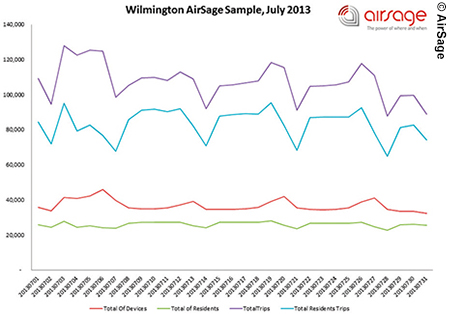U.S. Department of Transportation
Federal Highway Administration
1200 New Jersey Avenue, SE
Washington, DC 20590
202-366-4000
Federal Highway Administration Research and Technology
Coordinating, Developing, and Delivering Highway Transportation Innovations
| SUMMARY REPORT |
| This summary report is an archived publication and may contain dated technical, contact, and link information |
|
| Publication Number: FHWA-HRT-14-060 Date: July 2014 |
Publication Number: FHWA-HRT-14-060 Date: July 2014 |
In this next session, researchers from various agencies and academic institutions provided descriptions of the work they have been conducting and their uses of cellular data. Symposium participants then discussed challenges relating to sampling and dataset extrapolation.
Presentations
Cynthia Chen, University of Washington
Cynthia Chen identified certain challenges and limitations associated with the use of cell data. These include difficulties with penetration rates and sample sizes (e.g., in some markets users have multiple phones), as well as the varying market shares of different carriers. Another challenge is oscillation between two cell towers and therefore being unable to determine an exact location. In a preliminary dataset of 8,000 people, Chen was able to determine 90 percent of homes and workplaces within a certain area. Current key challenges that she and her team are working on include validation of trips and population expansion.
Xiaowei Xu, University of Arkansas
Xiaowei Xu conducted research that focuses on determining data clusters and associating individuals with groups of people or communities. He accomplished this through an algorithm that connects individuals’ social networking activities, as shown in figure 3. One specific example where Xu applied this algorithm was at college football games. Xu noted that challenges arise when cleaning and using data, as well as when finding a dynamic algorithm to enhance the result. Xu told the symposium participants that a major area to improve upon is to establish new methods for validating travel behavior by using cell data.

Figure 3. Clustering algorithm developed to represent individuals in a complex system.
Elizabeth Birriel, Florida Department of Transportation
Elizabeth Birriel explained that the Florida Department of Transportation (FDOT) has a desire to use cellular data to improve information used in 511 systems. These systems provide information about travel systems and travel routes. This information improvement was already achieved by using 2010 data, but it would be helpful to continue to refine these systems through the use of more data as coverage was strong for the interstate highway system but spotty for arterial roadways. FDOT is also looking at how cellular data and automated vehicles can be leveraged with each other moving forward.
Camille Kamga and Anil Yazici, City University of New York
Camille Kamga and Anil Yazici noted that they have used cellular data for mobility studies, specifically within New York City. One study involved using taxi data and determining that there is higher demand for taxis during inclement weather, as shown in figure 4. Data were also used to determine, as others have found, that the morning and afternoon peak periods are not symmetric. Further challenges and areas of research include determining the reason for these findings, for example, if changes in mobility are based on trip cancellations or mode shifts.

Figure 4. Taxi data used to determine demand for taxis during inclement weather.
Andrew Rohne, Ohio–Kentucky–Indiana Regional Council of Governments
Andrew Rohne used data from AirSage to attempt to model trips in his region of interest (greater Cincinnati, OH). In doing so, some challenges were identified regarding counts and capacities. Rohne compared his results using AirSage data to Ohio Department of Transportation and NHTS data to see how results matched and what the discrepancies were. Lessons learned and areas of future research include thinking through which data are available and what time of year the data would be most desirable for research purposes. Rohen also noted the possibility of incorporating cellular data in an NHTS expansion.
Krishnan Viswanathan, CDM Smith
Krishnan Viswanathan explained that he used data from AirSage to attempt to model trips in his region of interest (Wilmington, NC), as shown in figure 5. He derived various trips and examined different studies on non-home, residential, and home-to-home–based trips. To better understand movement and trips, Viswanathan noted that a possible next step would be to recruit users to willingly provide location data and demographic information.

Figure 5. AirSage cellphone data sample.
The symposium participants discussed several major themes during this session, as follows:
The symposium participants noted several key takeaways during the discussion, as follows: